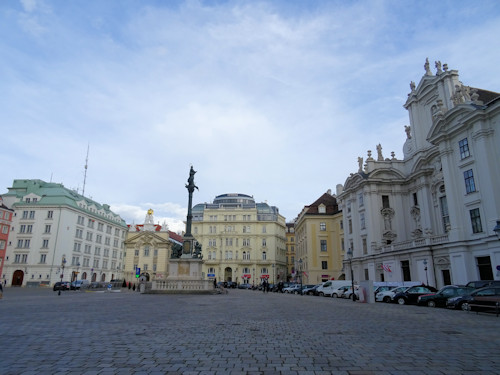
A huge square marks the historical centre of Vienna. As you might expect, Am Hof sits among various buildings of interest, from townhouses that hosted a young Mozart to former civil armouries and 14th-century churches.
- The area housed Heinrich II. Jasomirgott, first Duke of Austria, in the 1100s
- Look particularly for:
- …the Kirche am Hof church
- …Palais Collalto
- Home to notable Christmas and Easter markets, too
- Book a themed guided tour* for Vienna
- See also:
The buildings & history
(View across the square from the south)
When the gloriously-named Heinrich II. Jasomirgott set up court in the newly-created Duchy of Austria in the middle of the 12th century, he built his residence on what is now Am Hof.
Heinrich was not the first to live here, mind you.
For example, the area once formed part of the Roman military camp of Vindobona. Nevertheless, the Duke’s arrival marked the true beginning of a long and illustrious history for the location.
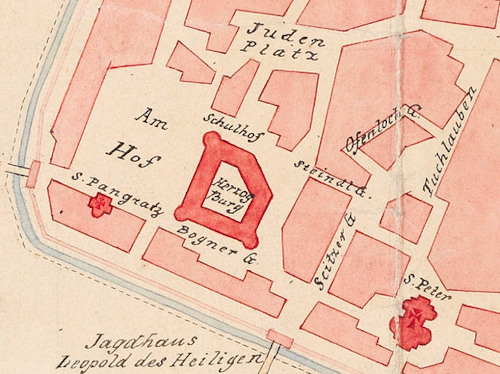
(Excerpt from a reconstructed map of Vienna in 1147; edited by Carl Graf Vasquez and produced in 1861. Am Hof is marked, as is Heinrich II’s castle or “Herzog Burg”; Wien Museum Inv.-Nr. 8404; reproduced with permission under the terms of the CC0 licence)
The court moved on just over a hundred years later, and Am Hof became a marketplace. So the Christmas and Easter markets on the square merely continue a centuries-old tradition.
Given the age and central position, quite a few historical buildings have graced the square’s edges…
The Mariensäule
Let us begin with the Mariensäule (Madonna column) in the centre, which dates back all the way to 1667 and the reign of Emperor Leopold I. The metal column and figures pay hommage to the immaculate conception.
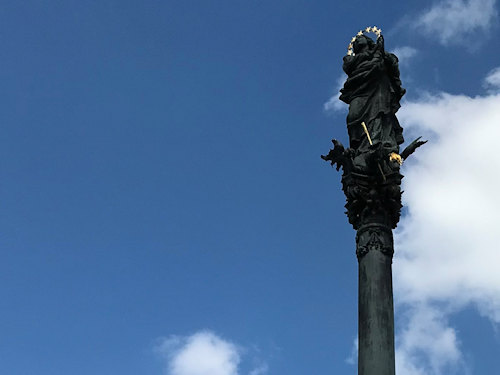
(A statue of Mary tops the column)
The column replaced a stone Mariensäule constructed around 20 years earlier in gratitude for Vienna remaining safe from the marauding Swedish army toward the end of the 30 Years War.
Leopold made a present of the original to a certain Count Georg Ludwig von Sinzendorf in Upper Austria, where it can still be seen today.
Kirche am Hof
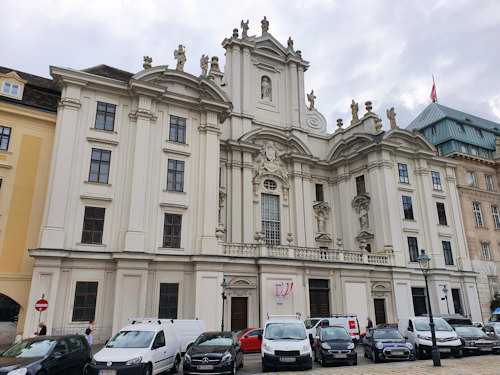
(Three popes have celebrated mass from the balcony)
Our first proper address is at Am Hof 1: the large imposing church that dominates one side of the square. Historians estimate construction began sometime in the 1380s, which makes the Kirche am Hof almost 650 years old.
As with so many such buildings, the church underwent extensive renovations and rebuilding through time. Most notably, the interior got a baroque makeover in the early 1600s and the façade got one in 1662.
Kirche am Hof actually stood in for a synagogue in Season 2 of the popular TV series, Vienna Blood.
Park Hyatt Vienna

(Luxury hotel and art fair venue)
Excavation work suggests Roman barracks once stood on the site of Am Hof 2.
Centuries later and the location still provides temporary accommodation for visitors from afar in the form of the Park Hotel Hyatt. The hotel also hosts Vienna’s Art at the Park art fair.
The neoclassical building is just over 100 years old and a former bank, which leads to another historical coincidence since the ducal mint once operated here.
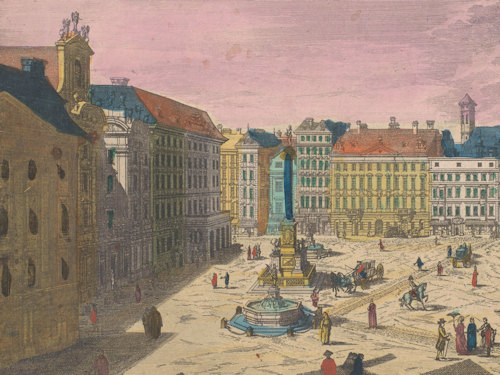
(Photo courtesy of the Rijksmuseum)
You can see the previous building at Am Hof 2 (the Habsburg equivalent of the Ministry of War) in the top left corner of the above picture, which dates back to sometime around the turn of the 18th and 19th centuries.
Am Hof 3-4

(One of the newest additions to the square)
Another location that goes back through the centuries. For example, a plaque on the wall reveals it was the site of the apostolic nunciature in Vienna between 1630 and 1913. Apparently, the future Pope Innocent XII worked here from 1668 to 1671.
Today’s building is “only” just over 100 years old, but still manages to squeeze in a little history: it once provided office space for the Nazi HQ of the Vienna administrative district. (Unsurprisingly, not something commemorated with a plaque.)
Am Hof 5
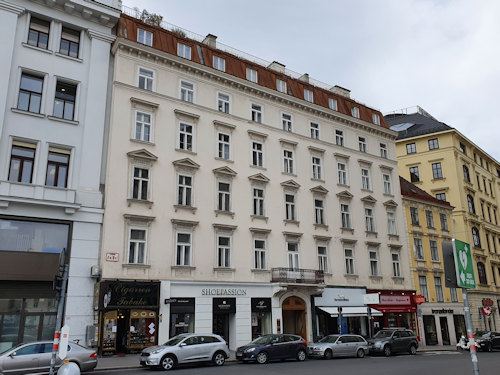
(Once a top cheese-related location. Be still my beating heart)
When you wander around the square, you find the kind of houses that might leave a lasting impression elsewhere, but earn little more than a shrug and a quick photo in central Vienna. So it is with Am Hof 5, built in 1820.
Though let’s throw in one historical fact: the municipal cheese exchange had premises at this location back in the late 1600s. That’s a concept I could get behind today.
Am Hof 6
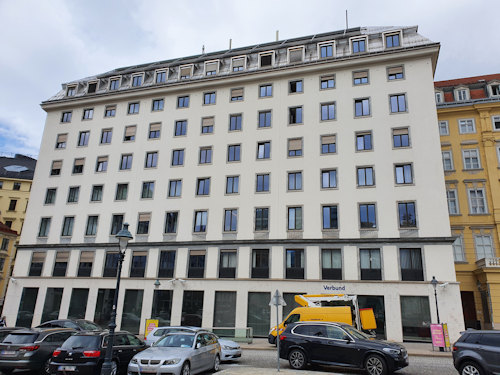
(The surprising location of a contemporary art installation)
This relatively new building (constructed in the 1950s after the previous one suffered extensive damage in WWII) houses the main offices of the Verbund electricity company. Notable for two reasons:
- The fiaker horse-drawn carriages pass along the street outside, so you can often get a suitable photo of one with the more historical-looking square as background
- The Yellow Fog art installation by Olafur Eliasson: at dusk, a fog (no prizes for guessing the colour) rises from where the walls meet the ground, creating an eerie effect intended to mark the change from day to night.
Incidentally, the building the office block replaced appears in The Third Man as the home of Anna Schmidt, the movie’s female lead. Am Hof appears elsewhere in the film, too.
Fire service buildings

(Fire service vehicles are a common sight here)
Once past the Verbund offices, you enter fire service territory, as the above photo demonstrates.
The buildings at Am Hof 7, 9, and 10 house the headquarters of the Vienna Fire Brigade, with, for example, offices, a museum, logistics departments and, of course, vehicles and emergency units.
Merkleinsches Haus

(Number 7)
Completed in 1730, this house at Am Hof 7 bears the name of its original owner, Christoph von Merklein. Needless to say, the building underwent various modifications in the intervening 300 years, perhaps seen most obviously in the exits put in last century for the fire engines.
The original architect, Johann Lukas Hildebrandt, left his mark elsewhere in Vienna, too. His most notable contribution was perhaps the palaces at Belvedere that now house some of the world’s greatest works of art: notably this one.
Am Hof 9-10
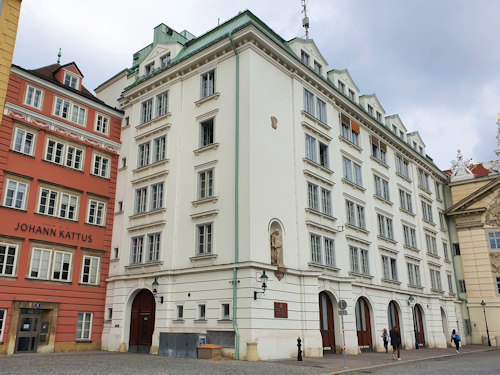
(Number 9)
The Vienna Fire Service has occupied these two locations since 1686. If the house at number 9 looks a little too modern, then that’s because it is. Add its predecessor to the list of places lost to WWII bombing. This photo from the late 19th century shows the previous building on the left:

(Photo courtesy of the Rijksmuseum)
Number 10 is the so-called Bürgerliches Zeughaus, which hints at an even earlier use for the building as a civil armoury in the 16th century.
Most of what you can see is from rebuilding and conversion work carried out in the early 1730s. The richly-decorated façade, for example, includes the inscription Anno MDCCXXXII.
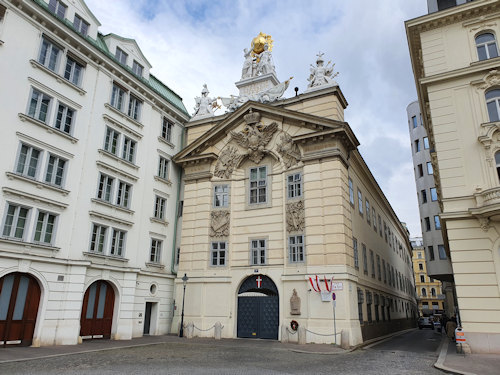
(The Bürgerliches Zeughaus at number 10)
At the very top stand two figures by Lorenzo Mattielli holding a golden sphere; the statues represent strength and perseverance. Mattielli is another of those artists whose work appears in many of Vienna’s landmark historical buildings, including the Karlskirche and Michaelerkirche churches.
The Narrow House

(Number 8)
Ah, but what about Am Hof 8?
The slender building at that address dates back to Renaissance times and squeezes in between the fire service’s premises. The large Johann Kattus lettering refers to the premises of a “trader in delicacies” that opened here in 1857. The Kattus family business is now a well-known producer of sparkling wine.
The Ledererhof
A small complex of houses used to reside at Am Hof 11, which is now a relatively new building from 1883. The tanners once had their guild hall in the old Ledererhof, and coffee houses and restaurants catered to the market stallholders on the square outside.

(Look for the golden ball to the left of the main entrance)
The current building continues the commercial tradition by providing office space for a major insurance company (among others).
Back in 1683, during the Ottoman siege of Vienna, an artillery ball apparently hit the house here and lodged within its walls.
The building’s owner had the ball painted gold (or covered in gold; I’m not sure which) and the house became known as Zur goldenen Kugel (English: “to the golden ball”). A plaque on the current building commemorates the event, and the actual ball hangs above it on an iron ring.
Am Hof 12
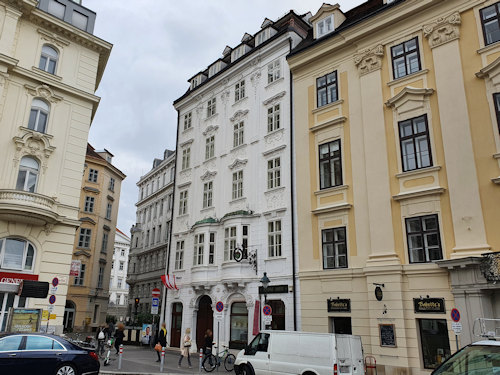
(The building marks the transition between Am Hof and the historical Jewish quarter)
The white-walled Baroque townhouse at the northeast corner of the square dates back centuries, but what you can see stems from around 1730.
Exiting the square here takes you through to Judenplatz square, home to both the Holocaust memorial designed by Rachel Whiteread and a building used by the Jewish Museum for exhibitions.
Palais Collalto
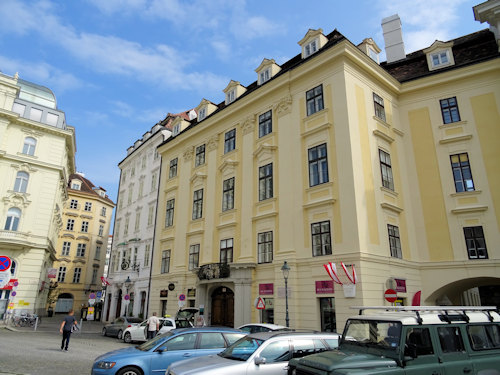
(Notable for a very famous child visitor in 1762)
And we complete our tour of Am Hof at number 13, the Collaltopalais, a late 17th century townhouse with an early 18th century façade.
The palais enjoys a particularly prominent place in the history of music thanks to a private concert given here in 1762. The performer was a young child named Wolfgang Amadeus Mozart; this was Mozart’s first ever public performance in Vienna.
Not a bad historical note to end on!
How to get to Am Hof
The square lies at one end of the pedestrianised area in the very centre of the city. Go to the westernmost point of the Graben and slip up Bognergasse or Naglergasse.
Subway: the nearest station is Herrengasse on the U3.
Tram/bus: no trams reach this part of Vienna, but bus routes through the old town pass nearby. Try the 1A or 3A to Schwertgasse. Or the 1A to Teinfaltstraße (a stop on another historic square just next door: the Freyung).
Address: Am Hof, 1010 Vienna
